Answers - Hesitation, Stumble, won't accelerate, no power, misfires, etc... Fixed
#1
I am posting this to share my recent experience with my '99 CLK430. I am an experienced mechanic. I've been working on cars/engines for more than 15 years, I attended UTI when I was young, but I do not work in the field. This is my first MB and I did not know the ins and outs well enough to jump right in and find/fix the problem I was having. I was very frustrated by the lack of response that I got on both MBWorld.org and Mercedesforum.com; as well as the general lack of detailed information available on the internet. I hope this provides some valuable information and references, and also helps anyone that may have any of the problems below.
I haven't owned this car very long, less than 2 years. I had an incident when I first got the car, where I apparently got some low-quality fuel, and the car began having acceleration problems. Talked to the local private MB shop, and they poured in a can of BG44K (Fuel System Cleaner), and that solved the problem. This problem started out the same way, and I thought I probably got some bad fuel again. BG44K did not fix the problem, so I changed out the fuel filter because it was about due, and also to make sure that it hadn't been plugged if indeed I had gotten bad fuel. This did not fix the problem either, and then it progressed.
This is when the serious problems began. It lost the ability to accelerate above about 3500 RPM, and also quit accelerating when I gave it more than about 50% throttle, and generally lacked power.. It started fine, idled okay, and ran decently as long as it was under (around) 3500 RPM and less than 50% throttle. Let me clarify, that at this point, I had gone through and done a basic inspection and there was nothing apparent that would be causing the problem. I even tested for vacuum leaks with propane and mass air cleaner. This is when I was advised to try replacing the MAF, I did, and it did not fix the problem. I began researching more about the car and the problem I was having. One day while I was driving, the car stalled and at first would not restart. It finally restarted but would barely accelerate. Once I got it home, I started troubleshooting and below is the sequence of events that followed and what I found:
I haven't owned this car very long, less than 2 years. I had an incident when I first got the car, where I apparently got some low-quality fuel, and the car began having acceleration problems. Talked to the local private MB shop, and they poured in a can of BG44K (Fuel System Cleaner), and that solved the problem. This problem started out the same way, and I thought I probably got some bad fuel again. BG44K did not fix the problem, so I changed out the fuel filter because it was about due, and also to make sure that it hadn't been plugged if indeed I had gotten bad fuel. This did not fix the problem either, and then it progressed.
This is when the serious problems began. It lost the ability to accelerate above about 3500 RPM, and also quit accelerating when I gave it more than about 50% throttle, and generally lacked power.. It started fine, idled okay, and ran decently as long as it was under (around) 3500 RPM and less than 50% throttle. Let me clarify, that at this point, I had gone through and done a basic inspection and there was nothing apparent that would be causing the problem. I even tested for vacuum leaks with propane and mass air cleaner. This is when I was advised to try replacing the MAF, I did, and it did not fix the problem. I began researching more about the car and the problem I was having. One day while I was driving, the car stalled and at first would not restart. It finally restarted but would barely accelerate. Once I got it home, I started troubleshooting and below is the sequence of events that followed and what I found:
#2
1. Bad Gas:
I opened the gas cap and took a whiff, all I could smell was VERY OLD gasoline, which smells like varnish. I filled a 5-gallon gas can, and added a bottle of fuel stabilizer. Poured that into the tank and gave it a few minutes to react. I restarted the car, and after it cleared the rest of that crap out of the fuel lines, it returned to “normal” where ran fine as long as it was under 3500rpm and 50% throttle.
2. Diagnostics and Sensors:
Up until this time, it did not trigger a CEL, finally the light came on. I ordered an ELM327 OBD-II adapter, and analyzed the trouble codes and the readings from all the sensors. The only codes it gave were Cylinder Misfire on 1, 2, 3, and 5; along with a Multiple Cylinder Misfire Code. All the sensors appeared to be functioning properly, and I did not see anything unusual. I posted graphs of the sensor data to see if anyone saw anything unusual, and I got no replies.
3. Catalytic Converters and Exhaust Backpressure:
I found a post on one of the MB forums, where a person who identified himself as an ASE Master Tech, described the EXACT set of symptoms that my car was having. He also got no replies. I emailed to ask if he found the cure, and he advised that both catalytic converters were plugged, and after replacing them the problem was solved. Please see his post:
https://mercedesforum.com/forum/gene...45/#post147505
So I removed the upstream O₂ sensors one at a time, and threaded in a pressure guage to check exhaust backpressure. I checked the backpressure first with the engine cold, and again with the cats at operating temperature, it was so low both times it barely registered on the guage. (Yes, I used a guage with a fine enough resolution to measure as low as 1-2 PSI)
4. Vacuum Lines:
I decided to take a closer look at the vacuum lines and valves, especially as they had linkage that connected to the manifold. (I did not suspect a vacuum leak because of the normal idle, the normal readings on the diagnostics, and the fact that no leak was indicated when testing with propane and solvent.) As I began carefully inspecting the lines, they looked fine. But when I flexed them they were full of cracks. Some of these cracks were all the way through the wall of the tube, but still were not apparent until the tube was flexed. Upon further inspection, I found a line that actually had a open hole in it, but it was on the backside where it was not visible.
(I should mention at this point that I live in the southwest, where it is VERY HOT and VERY DRY, both of which are bad for rubber, plastic, vinyl, leather, and other similar materials. The heat causes rubber to decay rapidly making it brittle and causing it to shrink. This car has repeatedly seen ambient Temps of 95 – 120 degrees F.)
These vacuum lines are used for the control of the variable intake system, which effectively changes the length of the intake runner, by opening and closing valves in the manifold. At low rpm's the valves are closed producing a "tunnel ram" effect in the long runners. My understanding is that the valves open somewhere around 3700 rpm, effectively shortening the length of the runner, as the long runner is not efficient at high speed, and can actually impede the air charge. Since I had no vacuum going to this device (due to the hole in the line), the valves were stuck closed all the time (Hence, no acceleration above 3500 rpm?). I decided to replace every vacuum line on the engine. One line however attaches in a port on the bottom side of the manifold. This line sheared off flush with the bottom of the manifold when I touched it, making it impossible to remove with the manifold on the car. The tube connects to a port that is actually recessed a couple of inches back into the manifold. In order to repair and replace the line, I had to remove the manifold.
5. Removing the Manifold:
Upon removing the manifold, I discovered that both the intake runners, the intake ports, and the intake valves were all coated with sand. (While cleaning my shorts, I began contemplating the logistics of selling it piece by piece on eBay.) Because the manifold is not supposed to be serviceable, I decided it would be best to order a new one. I happened to find one on eBay that night for $300 with a guarantee, so I ordered it. Then I decided to split my manifold open and take a look at it (seeing the inside of the manifold and how it was designed, I started to realize the bad vac lines were probably the source of my problem). Indeed, it was full of sand.
All the black stuff in the photo is sand covered in gas/oil...
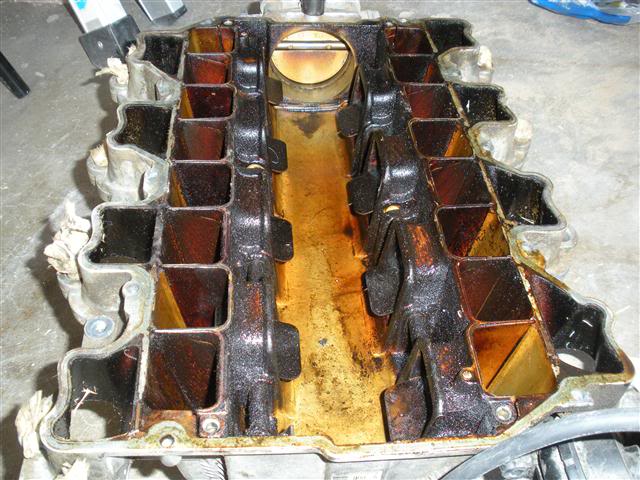
6. Removing the Sand:
I was lucky and only 2 cylinders had open intake valves. I spent an entire afternoon carefully cleaning the ports and valves with solvent and paper-towels. I adapted a wet-vac down to a clear, 1/4” line that I could insert into the port to remove sand and solvent during this process. I carefully wiped the walls of the ports with a paper-towel soaked in solvent. Then I sprayed the walls and the valves with B-12 Chemtool, while suctioning at the bottom of the port.
On the cylinders that had open intake valves, I removed a spark plug, and inserted the suction line into the cylinder. I did the same as on the other cylinders, but flushed the port with only small amounts of solvent, with the suction on to instantly remove the fluid/sand from the cylinder. The clear tubing allowed me to make sure that I was removing about the same volume of fluid as I was spraying in.
7. Spark Plugs:
While I had the engine partially disassembled, I decided to replace the spark plugs. They were coated with the same oily, sandy deposits that the ports were, so this turned out to be a good idea. When I was removing the coil packs, in order to access the plugs, I noticed that one of the plug-wires on cylinder 7 was not fully seated on the coil pack. The contacts were not in contact, and so it had been arcing creating a buildup of ashy deposits on both contacts, and also apparently creating a fair amount of heat as the plastic housing around the contact on the coil itself was distorted and cracked. The crack is only in the plastic around the contact, and not in the housing around the coil, and does not appear to affect the functionality of the coil. So I carefully filed down the deposits on both contacts until I had exposed bare metal.
8. Intake Gaskets:
This is about the time when my neighbor came over to ask if I was building a whole new Mercedes. I took a little time to clean up the new manifold as best as I could, again shooting solvent through the runners, and suctioning out what I could. I installed the throttle valve using a new O-ring, and then I installed the new manifold, and finished reassembling everything. During reassembly, I replaced all the rubber seals between the throttle actuator and the air filter housing. Again, the heat had caused all these seals to shrink and harden, leaving a gap for air to sneak by, bypassing the air filters, and in the case of the lower seals, also bypassing the MAF. This was probably the main cause of sand getting sucked into the motor.
9. Fuel Filter:
Upon restart, it ran much better but still had a stumble. The next day I filled up with gas, and added a good fuel system cleaner. As the solvent did it's work, it started running a little rough and started to throw misfire codes again for a short period, followed by triggering the CEL with no codes, and then returned pretty much to normal. The engine could rev all the way to redline again. But if I got above about 70% throttle, it would hesitate, although not nearly as bad as before. I hooked up the diagnostics and floored it and looked at all the sensor readings. Everything was okay except that the O₂ sensors were indicating a lean condition. I suspected fuel pressure, so I waited until I had used up all the gas with the fuel system solvent in it, and then replaced the filter.
10. Voila!
The car is back 100% back to normal with full power. And it runs smoother than it ever has since I've owned it.
A diagram of how the variable intake works:
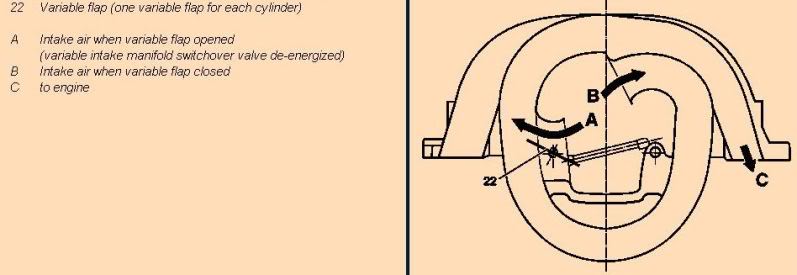
The black stuff in all these photos is sand covered with gas/oil...
This is the lower portion of the manifold, you can see the valves that control the variable intake. When they are open air enters through the valve, bypassing most of the length of the runner. The valley running down the middle is actually the top of a tank which acts as a vacuum reservoir.

This is the upper portion, or top, of the manifold. The ports down the center are where air enters when the valves are closed.
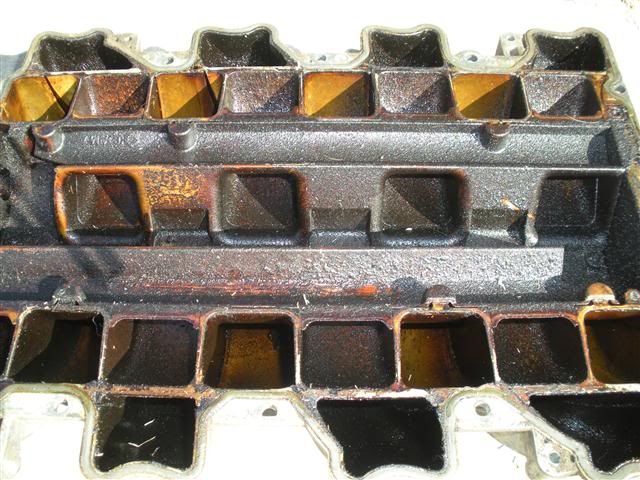
Here are some shots of the ports, you can see the buildup of sand on the walls and valves.
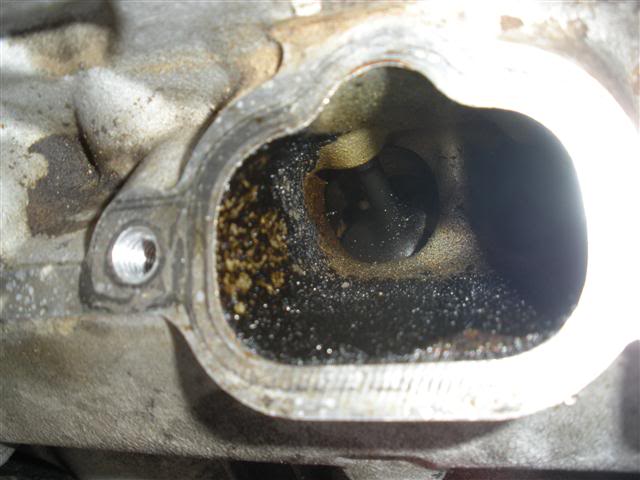
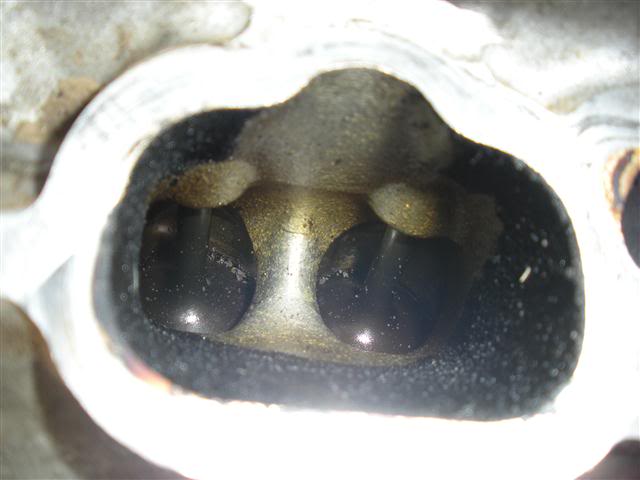
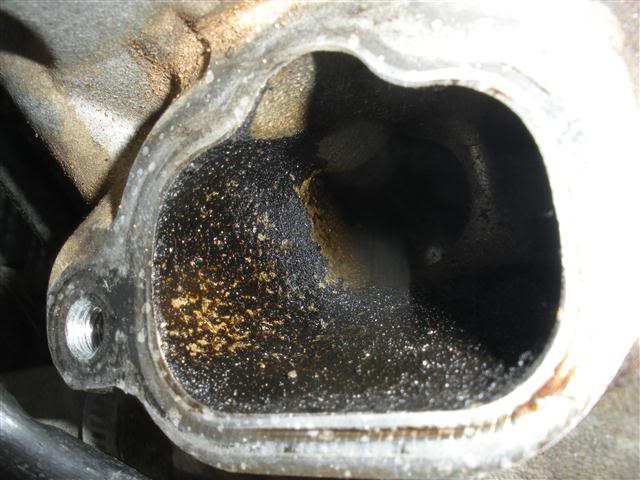
Here is one of the ports after cleaning:
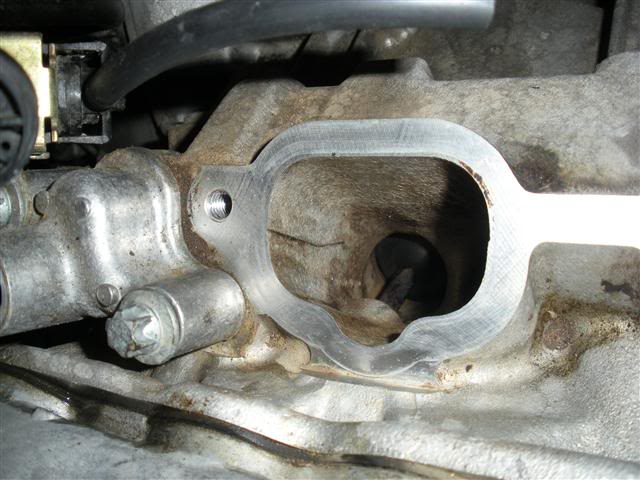
A couple shots of the motor with the intake off:
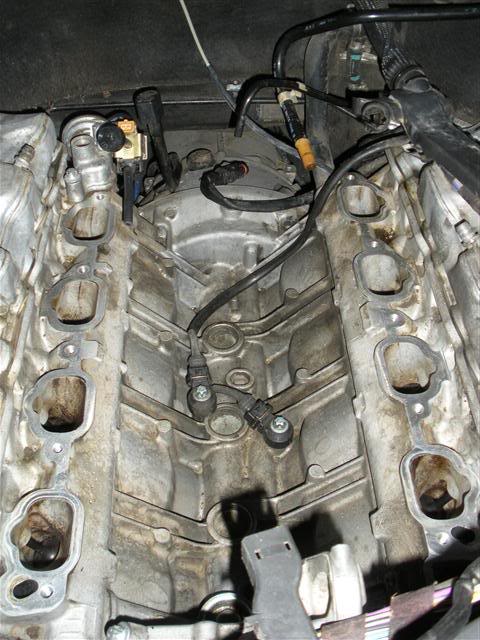
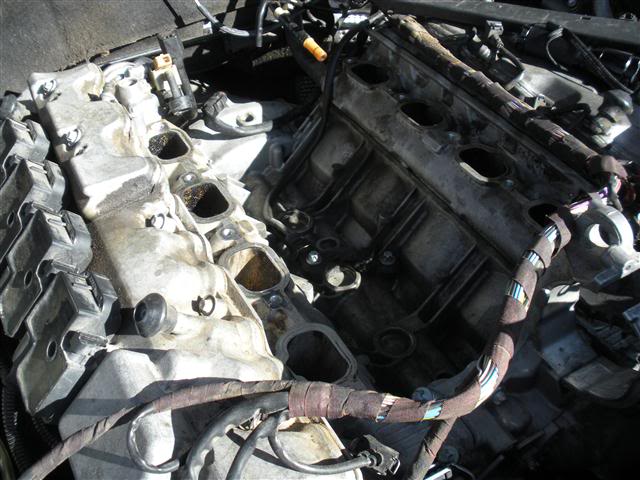
This is me when I realized there was sand in the motor...

I opened the gas cap and took a whiff, all I could smell was VERY OLD gasoline, which smells like varnish. I filled a 5-gallon gas can, and added a bottle of fuel stabilizer. Poured that into the tank and gave it a few minutes to react. I restarted the car, and after it cleared the rest of that crap out of the fuel lines, it returned to “normal” where ran fine as long as it was under 3500rpm and 50% throttle.
2. Diagnostics and Sensors:
Up until this time, it did not trigger a CEL, finally the light came on. I ordered an ELM327 OBD-II adapter, and analyzed the trouble codes and the readings from all the sensors. The only codes it gave were Cylinder Misfire on 1, 2, 3, and 5; along with a Multiple Cylinder Misfire Code. All the sensors appeared to be functioning properly, and I did not see anything unusual. I posted graphs of the sensor data to see if anyone saw anything unusual, and I got no replies.
3. Catalytic Converters and Exhaust Backpressure:
I found a post on one of the MB forums, where a person who identified himself as an ASE Master Tech, described the EXACT set of symptoms that my car was having. He also got no replies. I emailed to ask if he found the cure, and he advised that both catalytic converters were plugged, and after replacing them the problem was solved. Please see his post:
https://mercedesforum.com/forum/gene...45/#post147505
So I removed the upstream O₂ sensors one at a time, and threaded in a pressure guage to check exhaust backpressure. I checked the backpressure first with the engine cold, and again with the cats at operating temperature, it was so low both times it barely registered on the guage. (Yes, I used a guage with a fine enough resolution to measure as low as 1-2 PSI)
4. Vacuum Lines:
I decided to take a closer look at the vacuum lines and valves, especially as they had linkage that connected to the manifold. (I did not suspect a vacuum leak because of the normal idle, the normal readings on the diagnostics, and the fact that no leak was indicated when testing with propane and solvent.) As I began carefully inspecting the lines, they looked fine. But when I flexed them they were full of cracks. Some of these cracks were all the way through the wall of the tube, but still were not apparent until the tube was flexed. Upon further inspection, I found a line that actually had a open hole in it, but it was on the backside where it was not visible.
(I should mention at this point that I live in the southwest, where it is VERY HOT and VERY DRY, both of which are bad for rubber, plastic, vinyl, leather, and other similar materials. The heat causes rubber to decay rapidly making it brittle and causing it to shrink. This car has repeatedly seen ambient Temps of 95 – 120 degrees F.)
These vacuum lines are used for the control of the variable intake system, which effectively changes the length of the intake runner, by opening and closing valves in the manifold. At low rpm's the valves are closed producing a "tunnel ram" effect in the long runners. My understanding is that the valves open somewhere around 3700 rpm, effectively shortening the length of the runner, as the long runner is not efficient at high speed, and can actually impede the air charge. Since I had no vacuum going to this device (due to the hole in the line), the valves were stuck closed all the time (Hence, no acceleration above 3500 rpm?). I decided to replace every vacuum line on the engine. One line however attaches in a port on the bottom side of the manifold. This line sheared off flush with the bottom of the manifold when I touched it, making it impossible to remove with the manifold on the car. The tube connects to a port that is actually recessed a couple of inches back into the manifold. In order to repair and replace the line, I had to remove the manifold.
5. Removing the Manifold:
Upon removing the manifold, I discovered that both the intake runners, the intake ports, and the intake valves were all coated with sand. (While cleaning my shorts, I began contemplating the logistics of selling it piece by piece on eBay.) Because the manifold is not supposed to be serviceable, I decided it would be best to order a new one. I happened to find one on eBay that night for $300 with a guarantee, so I ordered it. Then I decided to split my manifold open and take a look at it (seeing the inside of the manifold and how it was designed, I started to realize the bad vac lines were probably the source of my problem). Indeed, it was full of sand.
All the black stuff in the photo is sand covered in gas/oil...

6. Removing the Sand:
I was lucky and only 2 cylinders had open intake valves. I spent an entire afternoon carefully cleaning the ports and valves with solvent and paper-towels. I adapted a wet-vac down to a clear, 1/4” line that I could insert into the port to remove sand and solvent during this process. I carefully wiped the walls of the ports with a paper-towel soaked in solvent. Then I sprayed the walls and the valves with B-12 Chemtool, while suctioning at the bottom of the port.
On the cylinders that had open intake valves, I removed a spark plug, and inserted the suction line into the cylinder. I did the same as on the other cylinders, but flushed the port with only small amounts of solvent, with the suction on to instantly remove the fluid/sand from the cylinder. The clear tubing allowed me to make sure that I was removing about the same volume of fluid as I was spraying in.
7. Spark Plugs:
While I had the engine partially disassembled, I decided to replace the spark plugs. They were coated with the same oily, sandy deposits that the ports were, so this turned out to be a good idea. When I was removing the coil packs, in order to access the plugs, I noticed that one of the plug-wires on cylinder 7 was not fully seated on the coil pack. The contacts were not in contact, and so it had been arcing creating a buildup of ashy deposits on both contacts, and also apparently creating a fair amount of heat as the plastic housing around the contact on the coil itself was distorted and cracked. The crack is only in the plastic around the contact, and not in the housing around the coil, and does not appear to affect the functionality of the coil. So I carefully filed down the deposits on both contacts until I had exposed bare metal.
8. Intake Gaskets:
This is about the time when my neighbor came over to ask if I was building a whole new Mercedes. I took a little time to clean up the new manifold as best as I could, again shooting solvent through the runners, and suctioning out what I could. I installed the throttle valve using a new O-ring, and then I installed the new manifold, and finished reassembling everything. During reassembly, I replaced all the rubber seals between the throttle actuator and the air filter housing. Again, the heat had caused all these seals to shrink and harden, leaving a gap for air to sneak by, bypassing the air filters, and in the case of the lower seals, also bypassing the MAF. This was probably the main cause of sand getting sucked into the motor.
9. Fuel Filter:
Upon restart, it ran much better but still had a stumble. The next day I filled up with gas, and added a good fuel system cleaner. As the solvent did it's work, it started running a little rough and started to throw misfire codes again for a short period, followed by triggering the CEL with no codes, and then returned pretty much to normal. The engine could rev all the way to redline again. But if I got above about 70% throttle, it would hesitate, although not nearly as bad as before. I hooked up the diagnostics and floored it and looked at all the sensor readings. Everything was okay except that the O₂ sensors were indicating a lean condition. I suspected fuel pressure, so I waited until I had used up all the gas with the fuel system solvent in it, and then replaced the filter.
10. Voila!
The car is back 100% back to normal with full power. And it runs smoother than it ever has since I've owned it.
A diagram of how the variable intake works:

The black stuff in all these photos is sand covered with gas/oil...
This is the lower portion of the manifold, you can see the valves that control the variable intake. When they are open air enters through the valve, bypassing most of the length of the runner. The valley running down the middle is actually the top of a tank which acts as a vacuum reservoir.

This is the upper portion, or top, of the manifold. The ports down the center are where air enters when the valves are closed.

Here are some shots of the ports, you can see the buildup of sand on the walls and valves.



Here is one of the ports after cleaning:

A couple shots of the motor with the intake off:


This is me when I realized there was sand in the motor...

Last edited by Senorking; 03-25-2011 at 07:35 AM.
#3
Additional information and resources:
1. Mercedes Specification and Resource Site:
Mercedes-Benz Specification Site - Marcus Fitzhugh
2. CLK430 Engine Design Article
Mercedes-Benz Specification Site W208 CLK430 Engine Details - Marcus Fitzhugh
3. CLK430 DIY and Specs Site
Signal to Noise - Marcus Fitzhugh
4. Mercedes Trouble Codes Page
http://www.engine-light-help.com/mer...ine-light.html
5. Inexpensive OBD-II Adapters and diagnostic software for PC - USB or Bluetooth
Amazon.com:
6. Mercedes Service Software for PC:
I purchased the Mercedes software from ebay for less than $20, on DVD. Works great. There are lots available for around that price on eBay, find one that you like.
7. Free up-to-date Mercedes-Benz Parts Diagrams with part #'s:
https://epc.startekinfo.com/epc/
1. Mercedes Specification and Resource Site:
Mercedes-Benz Specification Site - Marcus Fitzhugh
2. CLK430 Engine Design Article
Mercedes-Benz Specification Site W208 CLK430 Engine Details - Marcus Fitzhugh
3. CLK430 DIY and Specs Site
Signal to Noise - Marcus Fitzhugh
4. Mercedes Trouble Codes Page
http://www.engine-light-help.com/mer...ine-light.html
5. Inexpensive OBD-II Adapters and diagnostic software for PC - USB or Bluetooth
Amazon.com:
6. Mercedes Service Software for PC:
I purchased the Mercedes software from ebay for less than $20, on DVD. Works great. There are lots available for around that price on eBay, find one that you like.
7. Free up-to-date Mercedes-Benz Parts Diagrams with part #'s:
https://epc.startekinfo.com/epc/
Thread
Thread Starter
Forum
Replies
Last Post
MBenzAMG
For Sale / Trade Classifieds
0
11-08-2013 03:50 PM



